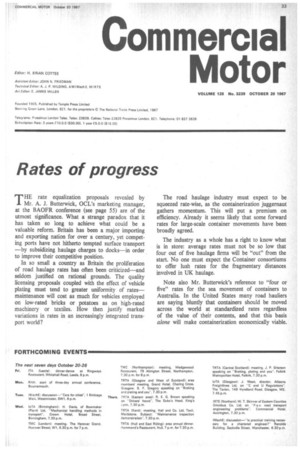Rates of progress
Page 35

If you've noticed an error in this article please click here to report it so we can fix it.
FT HE rate equalization proposals revealed by Mr. A. J. Butterwick, OCL's marketing manager, at the BAOFR conference (see page 55) are of the utmost significance. What a strange paradox that it has taken so long to achieve what could be a valuable reform. Britain has been a major importing and exporting nation for over a century, yet competing ports have not hitherto tempted surface transport —by subsidizing haulage charges to docks—in order to improve their competitive position.
In so small a country as Britain the proliferation of road haulage rates has often been criticized—and seldom justified on rational grounds. The quality licensing proposals coupled with the effect of vehicle plating must tend to greater uniformity of rates— maintenance will cost as much for vehicles employed on low-rated bricks or potatoes as on high-rated machinery or textiles. How then justify marked variations in rates in an increasingly integrated transport world? The road haulage industry must expect to be squeezed rate-wise, as the containerization juggernaut gathers momentum. This will put a premium on efficiency. Already it seems likely that some forward rates for large-scale container movements have been broadly agreed.
The industry as a whole has a right to know what is in store: average rates must not be so low that four out of five haulage firms will be "out" from the start. No one must expect the Container consortiums to offer lush rates for the fragmentary distances involved in UK haulage.
Note also Mr. Butterwick's reference to "four or five" rates for the sea movement of containers to Australia. In the United States many road hauliers are saying bluntly that containers should be moved across the world at standardized rates regardless of the value of their contents, and that this basis alone will make containerization economically viable.








































































































































